Many women have found that yoga for menopause, including restorative and supportive poses, may improve the undesirable but common side effects, including hot flashes, stress, depression, lack of sleep, and more.
Here are a few specific yoga poses that may relieve these menopausal symptoms. We encourage you to give these a try!
Yoga for Menopause?
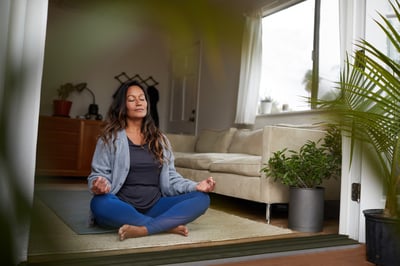
Using yoga to manage menopausal symptoms like pain relief and stress can be rewarding. Think about how your body typically experiences menopause symptoms—your stomach and digestive system may be upset often, your emotions are off, your mind feels foggy, and you may encounter trouble sleeping.
As your body goes through menopausal changes, it may also experience changes associated with age, such as muscle loss and degenerating joints. All of these areas can be targeted for relief through certain yoga poses.
Yoga can reduce the emotional symptoms of menopause, doing more than just treating the physical pain.
Restorative yoga requires poses to be held for longer than in conventional yoga, often with the support of props, such as folded blankets, to relax the body. These postures relax the nervous system.
There are several different schools of yoga out there, and countless poses and adaptations. It can be overwhelming to start from scratch! Whether you have a significant amount of yoga experience or none at all, we want you to be able to use yoga to help relieve your menopausal symptoms and discomforts.
If you experience pain or discomfort with any of these poses, eliminate it from this routine or seek out instruction from a certified yoga instructor.
Learn everything you need to know about menopause, including ways to ease symptoms, here!
Yoga for Menopausal Stress Relief, Depression, Digestion & More
1. Shoulderstand (Salamba Sarvangasana)
.png?width=2045&name=Shoulderstand-combo%20(1).png) Start by lying down on your mat. Consider adding two folded blankets under each shoulder for support. Slide your hips up against the wall and straighten your legs against the wall. Bring your toes to your nose (flexed feet). If this pose feels too easy, progress to the next exercise.
Start by lying down on your mat. Consider adding two folded blankets under each shoulder for support. Slide your hips up against the wall and straighten your legs against the wall. Bring your toes to your nose (flexed feet). If this pose feels too easy, progress to the next exercise.
Your next progression is to hold the legs in the air unassisted by the wall.
Eventually, you will progress into a shoulder stand by putting your body into a bridge pose. Start by lying down on your back and lifting your hips off your mat, keeping your arms next to your body with your palms facing down. Begin the process of getting your legs in the air by lifting one leg at a time. After using your palms to leverage yourself and lift one leg, bring your hands to your lower back to create a stable shelf for your balance. Now, with this shelf in place, lift your other leg as well.
Note: Make sure you don’t turn or move your head back and forth as you do this; just keep your neck straight and fix your gaze upward to avoid neck injuries with this pose.
For additional support, move your hands either further up your back or lower depending on where you originally placed your hands and what is most comfortable for you.
HOLD: Hold this pose for 10 deep inhalations and exhalations. Then roll out of it by either slowly releasing your legs downward or bringing them over your head, and then rolling your spine to the floor.
Benefits
- Calms the brain and helps relieve stress and mild depression
- Stretches the shoulders and neck
- Tones the legs and buttocks
- Improves digestion
- Helps relieve the symptoms of menopause
- Reduces fatigue and alleviates insomnia
Cautions
- Diarrhea
- Headache
- High blood pressure
- Neck injury
2. Marichi's Pose (Marichyasana A)
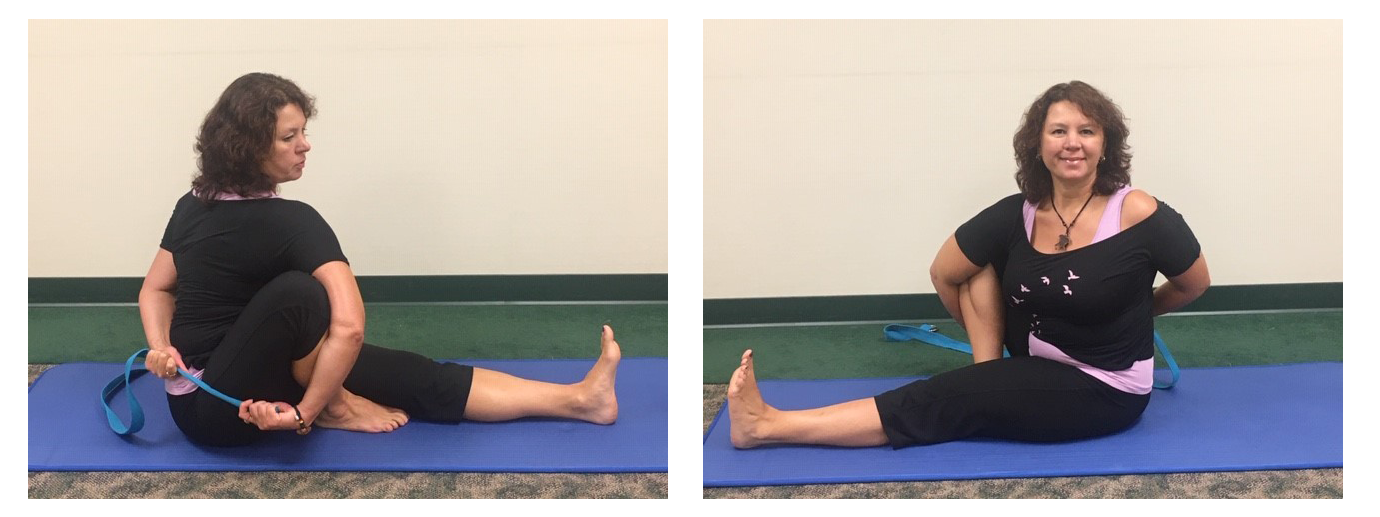 Begin by sitting on your mat with your legs extended in front of you, toes pointing upward (flexed feet). Next, bend your left knee and move it so that your foot is now resting on your mat. Place your left shin behind or in your left armpit.
Begin by sitting on your mat with your legs extended in front of you, toes pointing upward (flexed feet). Next, bend your left knee and move it so that your foot is now resting on your mat. Place your left shin behind or in your left armpit.
Hold onto a belt, a necktie, a rolled-up beach towel, or a yoga strap. When you’re ready, reach your left arm around the outside of your left leg and reach for your back. At this time, your right arm should also reach back in hopes of meeting the belt, tie, towel, or strap. Leave as much room between your hands as your body allows. Your ultimate goal is to join hands, deepening the stretch.
HOLD: Keep this stretch for 30 seconds to 1 minute. Add deep breaths while you hold this stretch, full inhalations, and exhalations. As you sit back up, take a deep breath in. Repeat these steps with your other leg bent up.
Benefits
- Calms the brain
- Stretches the spine and shoulders
- Improves digestion
- A therapeutic application for flatulence, constipation, and obesity
Cautions
- Asthma
- Diarrhea
When does perimenopause typically start, and how long does it last? Read this blog to learn everything you need to know about perimenopause!
3. Head-to-Knee Forward Bend (Janu Sirsasana)
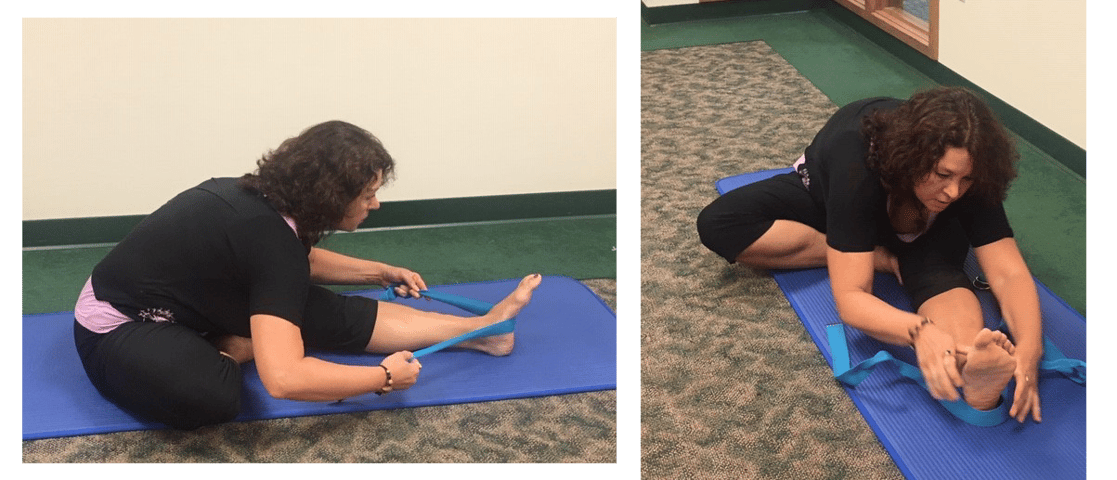 Start by sitting on your mat with your legs outstretched in front of you. Next, bend your right knee and move it so that the bottom of your foot is up against your left thigh, forming a right angle with your left leg. Think about making a number 4 shape with your body.
Start by sitting on your mat with your legs outstretched in front of you. Next, bend your right knee and move it so that the bottom of your foot is up against your left thigh, forming a right angle with your left leg. Think about making a number 4 shape with your body.
Keep your belly button in line with the center of your left leg and bend at your groin as you try to touch your head to your knee. If your knee on your left leg does not touch, put a towel underneath for support. Take your belt, tie, towel, or yoga strap and wrap it around the bottom of one foot and pull your chest to your leg, allowing the strap to help support the stretch. Your next progression is to have your arms stretched out and grab your left foot for a further and deeper stretch.
HOLD: Keep this stretch for anywhere between 30 seconds and 3 minutes. Don’t forget to breathe through your stretch and take a deep inhale as you sit back up, and repeat with bending your left knee.
Benefits
- Calms the brain and helps relieve mild depression
- Stretches the spine, shoulders, hamstrings, and groins
- Improves digestion
- Helps relieve the symptoms of menopause
- Relieves anxiety, fatigue, and headaches
Cautions
- Asthma
- Diarrhea
- Avoid full knee bends or flexes if you have any history of a knee injury
Yoga for Hot Flashes
If you are experiencing hot flashes, incorporate restorative and cooling poses into your yoga or daily routine. Too much tension in your body or the need to grip or hold on to something can make hot flashes worse. We suggest using bolsters, blankets, or blocks to support your entire body. Reclined poses with proper support can also help create complete relaxation.
4. Reclining Bound Angle Pose (Supta Baddha Konasana)
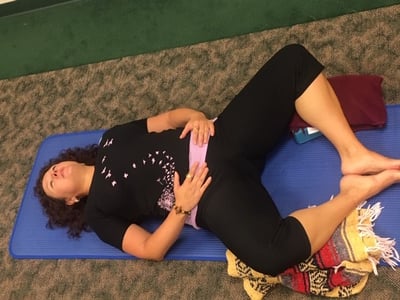
Begin by sitting up on your mat with your legs extended in front of you. Bend your knees up and bring the bottoms of your feet together, making a diamond shape between your legs. Slowly drop your knees opposite each other as you lean backward.
As you lean back, start by gently bringing your elbows to your mat if you need extra abdominal support. Lie your entire back on your mat or blanket, resting your knees on the other blankets or blocks. Modify your buttocks’ position to create a natural curve in your lower back. This modification means you may want to shift your lower weight from the bottom of your buttocks to the upper backside of it.
Drop all of the tension in your body, starting from your toes, to your knees, to your arms (palms facing up), to your shoulders, neck, head, and spine. As you close your eyes, release every source of stress and tightness and fully relax your body.
HOLD: Rest for up to 10 minutes in this position. Breathe deeply when holding this pose. When done, bring your knees together, roll onto your side, and slowly use your arms to push off your mat to bring yourself back up to a seated position.
Benefits
- Decreases tension in your muscles and body
- Relieves fatigue by increasing energy levels
- Stretches the inner thighs, groin, and knees
- Helps relieve the symptoms of stress, mild depression, and menopause
Cautions
Avoid this pose if you have a groin or knee injury unless you are under the guidance of a professional instructor or you use a blanket or block supports under your outer thighs.
If you’re between the ages of 35 and 50, you have a unique opportunity to positively impact your future health through the choices made today, following preventive health care and healthy habits. Improve future wellness through early perimenopause, perimenopause, and early menopause. Learn more now.
5. Downward-Facing Dog (Adho Mukha Svanasana)
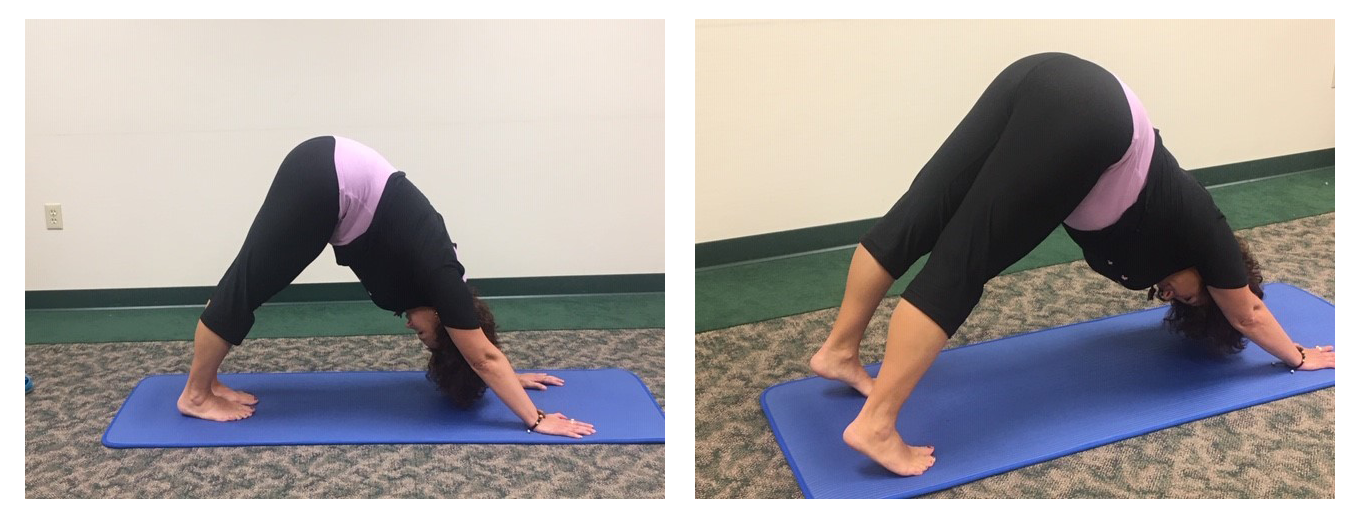 Begin with your hands and knees on the mat with your hips and knees lined up and your hands directly under your shoulders. Curl your toes under and straighten your leg as much as you can as you push up with your hands. If your heels don't rest flat on the ground, no worries. Position your heels as close to the floor as you can. With practice, you will become more flexible and your heels will eventually connect to the floor.
Begin with your hands and knees on the mat with your hips and knees lined up and your hands directly under your shoulders. Curl your toes under and straighten your leg as much as you can as you push up with your hands. If your heels don't rest flat on the ground, no worries. Position your heels as close to the floor as you can. With practice, you will become more flexible and your heels will eventually connect to the floor.
Drop your head so your ears line up with your shoulders and lean into the stretch. As you relax your back muscles, you may feel more tightness in your legs.
HOLD: Try to hold this pose for 10 - 20 seconds, slowly inhaling and exhaling with each count. When done, push your body forward and slowly lower your knees, body, and arms - bending at the elbows.
Benefits
- Calms the brain and helps relieve stress and mild depression
- Energizes the body
- Stretches the shoulders, hamstrings, calves, arches, and hands
- Strengthens the arms and legs
- Helps relieve the symptoms of menopause
- Helps prevent osteoporosis
- Improves digestion
- Relieves headache, insomnia, back pain, and fatigue
- Therapeutic for flat feet and sciatica
6. Reclining Hero Pose (Supta Virasana)
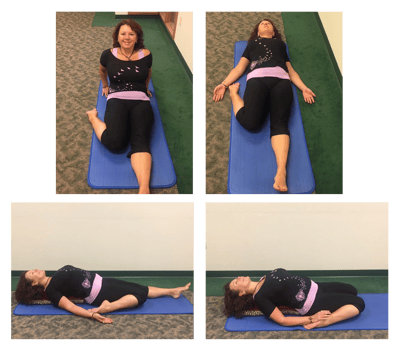 Start by sitting up on your mat with your feet out in front of you and your buttocks against your support you’ve chosen to lean on; this could be blankets, pillows, or cushions.
Start by sitting up on your mat with your feet out in front of you and your buttocks against your support you’ve chosen to lean on; this could be blankets, pillows, or cushions.
While keeping your knees touching your mat, slide your feet to either side of your thighs.
Now you should begin lowering yourself backward by first leaning onto your elbows and forearms. Slowly lower the rest of your body and back either onto the mat or onto your supportive blocks or blankets. If you experience pain or discomfort in your lower back or knees, this means you should either use cushions for support or add more support.
Keep your knees as close together as possible as you continue to breathe attentively.
HOLD: Stay reclined and relaxed in this position for 30 seconds. Inhale feeling your lungs fully inflate. Exhale until all air in lungs is exhausted. When done, bring yourself up by first moving to your forearms and elbows then slowly return to the sitting up position while restoring your feet out in front of you.
Benefits
- Stretches the abdomen, thighs, deep hip flexors (psoas), knees, and ankles
- Strengthens the arches
- Relieves tired legs
- Improves digestion
Cautions
Avoid this pose if you have severe back, knee, or ankle problems unless you have guidance from an experienced instructor.
7. Bridge Pose (Setu Bandha Sarvangasana)
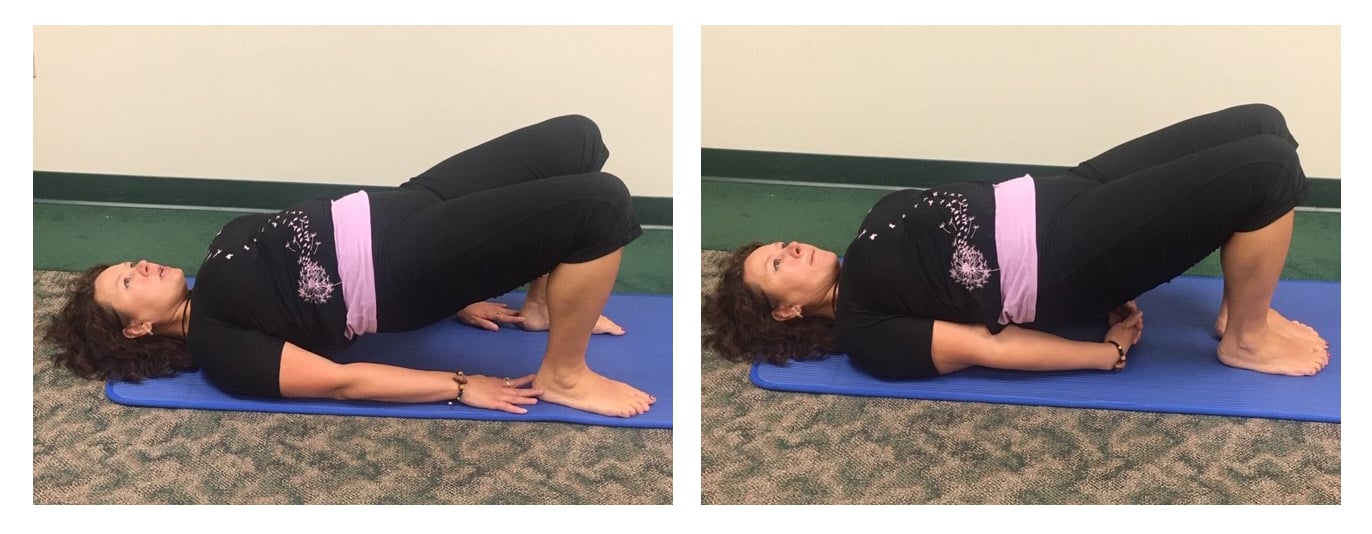 Begin on your mat by lying flat on your back. If needed, place a supportive blanket under your neck and shoulders. With your hands flat on the mat, palms down, bend your knees to put your feet flat on the mat as well.
Begin on your mat by lying flat on your back. If needed, place a supportive blanket under your neck and shoulders. With your hands flat on the mat, palms down, bend your knees to put your feet flat on the mat as well.
Place your heels as close to your buttocks as possible and then lift your buttocks off your mat. Underneath your lifted body, bring your hands as close as you can. If you can hold hands, clasp them together.
Lift your pelvic area as high as possible, stay on the tops of your shoulders, and use your arms as support by pressing into the mat. Keep your chin up to the sky and don’t forget to breathe.
HOLD: Keep this pose for 30 seconds to 1 minute. Slowly release your spine back to the mat by starting at your shoulders and continuing to roll the rest down as well with an exhale.
Benefits
- Stretches the chest, neck, and spine
- Calms the brain and helps alleviate stress and mild depression
- Improves digestion
- Helps relieve the symptoms of menopause
- Reduces anxiety, fatigue, backache, headache, and insomnia
- Therapeutic for osteoporosis and sinusitis
Cautions
Avoid this pose if you have a neck injury unless you are under the guidance of an experienced trainer.
8. Wide-Legged Forward Bend (Prasarita Padottanasana)
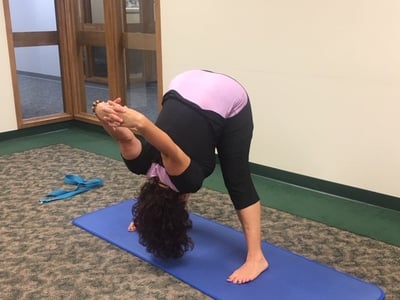 Begin by standing on your mat sideways. Next, spread your legs apart, about three feet apart from each other. Keep your feet parallel to each other and straight.
Begin by standing on your mat sideways. Next, spread your legs apart, about three feet apart from each other. Keep your feet parallel to each other and straight.
Place your hands on your hips and slowly hinge forward from your hips. Begin by forming a 90-degree angle with your upper body and hips.
Release your arms and connect them behind your back. If your hands don't reach, use your belt, tie, towel, or yoga strap. Hold on for assistance, bringing your hands as close together as possible. As you connect your hands, begin slowly moving the rest of your upper body closer to your mat so that your head falls directly between your feet. At this point, allow your arms to follow your upper body and fall towards the mat as well, over the top of your head.
Keep a distance between your shoulders and ears as you continue to stretch your arms, neck, and the back of your legs.
HOLD: Stay in this pose for 30 seconds to 1 minute. As you stretch, breathe deeply. As you finish, release your arms so they fall towards the mat, lift your upper body back to a standing position, and walk your legs back together again.
Benefits
- Strengthens and stretches the inner and back legs and the spine
- Tones the abdominal muscles
- Calms the brain
- Relieves mild backache
- Therapeutic application for headaches, fatigue, and mild depression
Cautions
Avoid the full forward bend if you have lower-back problems. Move through the motion. Stop right before you feel pain.
How Moreland OB-GYN Can Help
If you experience menopausal symptoms that are interfering with your life, we are here to help. Our providers are ready to listen, understand, and provide expert care.
At Moreland, we are committed to being a premier destination for women in the Waukesha community seeking care related to menopause. We are proud to have three providers, Dr. Allison Nelson (MD,FACOG,NCMP), Lorree L. Dyoco (M.D., FACOG, NCMP), and Dr. Matthew Taylor (MD,FACOG,NCMP), who are Menopause Society Certified Practitioners (MSCP), reflecting our commitment to all patients.
Learn more about how our Menopause Society Certified Practitioners (MSCP) can help you transition through menopause,helping you feel like yourself and live your most fulfilling life at any age.










